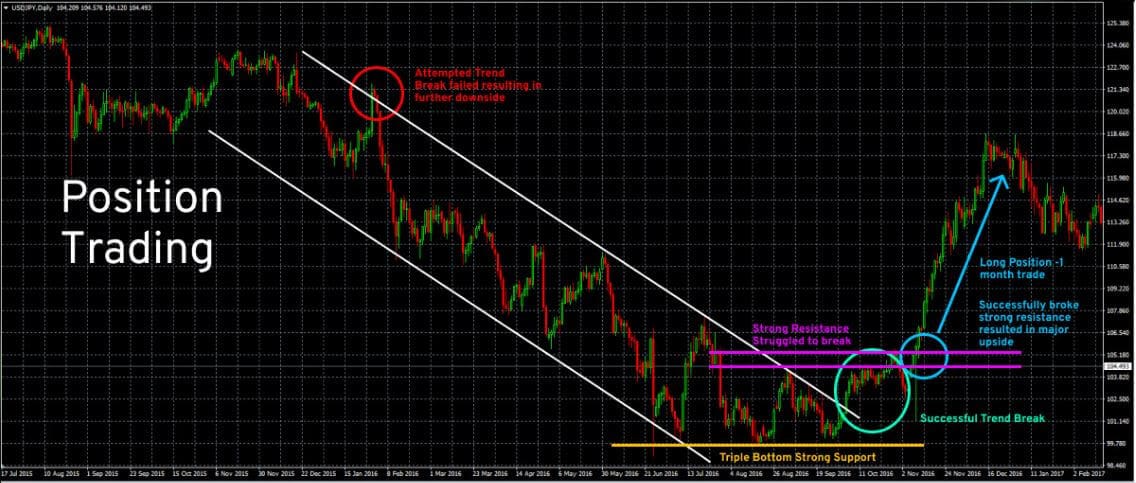Evolution of a Trader: Position Trading
*OspreyFX would like to state that traders should research extensively before following any information given hereby. Any assumptions made in this article are provided solely for entertainment purposes and not for traders to guide or alter their positions. Please read our Terms & Conditions and Risk Disclosure for more information.
Evolution of a Trader: Position Trading
What is Position Trading?
Position trading is a long-term trading strategy under which traders hold their positions for extended periods. This means it could go from a few months to a few years and is a rather popular approach to the market. Position trading focuses on a given asset’s future outlook for growth and ignores the short-term intraday fluctuations or trends.
How to Become a Position Trader
Contrary to a day trading strategy, a position trader aims to buy and hold his assets until they peak and exit at a profit. Position trading offers flexibility to those who have a full-time job or other responsibilities and don’t have as much time to devote to the market.
Position trading is a great way to get your feet wet too! Since the trader will execute fewer trades than a day trader, there is no need to worry about short term trends. Therefore you don’t have to deal with the stress associated with trading on a tighter time frame. What’s more, you are more likely to stick to a trading budget as a position trader. Without being in front of the screen all day, your impulse to trade is substantially diminished.
Since position trading requires you to hold onto an asset, you will most likely factor in other strategies to monitor the market trends. Ideally, the trader should be familiar with technical and fundamental analysis. Both are essential for the development of any asset and market in the long-term. Traders will base their approach on long-term charts from daily to monthly, while continuously factoring in the current macroeconomic state and its outlook.
The Qualities of a Successful Position Trader
- Strong understanding of the market
- Research skills and technical analysis
- Ability to recognize chart patterns
- Patience and discipline
- Doesn’t act or react emotionally
- Money management skills
Useful Indicators for Position Trading
On the technical front, position traders use long-term indicators to identify where the trend is now. Whether it’s bullish or bearish, and what the momentum can tell regarding future movements.
The most widely used indicator when approaching the market in the long-term is the 200-day simple moving average. The 200SMA represents the average price over the past 200 days. Traders can evaluate an oversold or overbought market by relying on the 200SMA. This works best in combination with the Moving average convergence divergence indicator (MACD).
Additionally, traders can use 50-day and 100-day moving averages to smooth out price trends on a shorter-term price fluctuation. Some traders also employ support and resistance levels in their approach to spot long-term trends prior to formation.

The Importance of Fundamental Analysis in Position Trading
Fundamental analysis, on the other hand, is also highly important for successful position trading. The position trader is supposed to evaluate the potential worth of the asset for months ahead. In this regard, they should have a good understanding of market fundamentals.
For example, when entering a position trade in a currency pair, the trader needs to be aware of the overall macroeconomic environment, monetary policy, projected unemployment data, and other key economic indicators.
If the position trade is in stocks, then a trader needs to be familiar with the growth outlook of the company. For example, learning about the company’s business model, competitive advantages, projected earnings, etc.
Position trading can include any market such as bonds, indexes, stocks, currencies, commodities.
For a successful position trade to be placed, the market needs to suggest that a major trend will happen. And the goal of the position trader is to enter the market and stay for the long-term. This strategy is also called “buy-and-hold” as it assumes that the market participant enters without paying attention to the daily noise on the charts. A sell is supposed to be executed when the trend breaks. This approach, a rather passive one, is very suitable for people who want to invest in the market without being actively involved.
Position traders aim to make no more than a few trades every year. The prospect for growth should be sufficient, given that the assets they hold are strong performers, and the trend is moving in their favor.
Position Trading vs Investing
What’s the difference between position traders and investors? This is one of the most frequently asked questions. Generally, an investor will take a more relaxed approach to the market and seek a large return through a buy and hold stock. A position trader will need to monitor the market and will enter and exit positions more regularly, waiting for a trend to peak.
Both investors and traders require a strong understanding of the market to succeed, and there are always risks involved.
Conclusion
Position trading is a popular trading style that requires less commitment from the trader. It can be done on a part-time basis and is considerably less stressful because of the buy and hold concept. By adopting a position trading strategy, you are also able to eliminate the market noise and intensity of short term trends by limiting your screen time.
Like any trading strategy, education is key. If position trading seems like something you are ready for, we recommend that you study up on it! Follow blogs and subscribe to trading videos to sharpen your skills, and then, test out your strategies on a platform you can trust- OspreyFX!